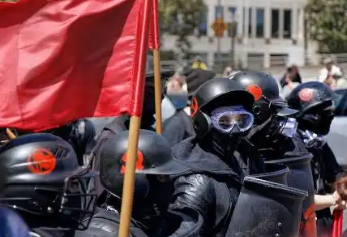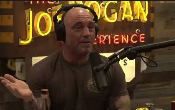
On June 29, 2019, journalist Andy Ngo was covering a standoff between Antifa and the Proud Boys in Portland, Oregon. Black-clad Antifa rioters punched him in the head, kicked him, and beat him so badly he suffered a brain hemorrhage. Ngo’s work covering Antifa in Portland and across the United States has made him a target: he has photos of slogans such as “KILL ANDY NGO” spray-painted in enormous letters on walls; Antifa members have showed up at his front door late at night in black bloc, each wearing masks of his face. Reluctantly, Ngo recently decided that he had no choice but to leave his hometown and the United States for a while.
“I had to flee Portland because of the rising death threats against me and the deteriorating security situation, with police having been defunded by the millions and officers resigning and leaving the force and the city experiencing skyrocketing crime and homicides,” Ngo told me. “It was already dangerous enough to go on the ground, but it was becoming dangerous just to live there—to go grocery shopping, or to a restaurant, or to the gym, because I would get recognized and they would publicize where I could be found. I ended up leaving the country and going to the U.K.”
In May 2021, Ngo attempted to cover an Antifa demonstration in disguise on a trip home; he was recognized, chased, and beaten bloody.
Due to his years-long coverage of Antifa, Andy Ngo is one of the most threatened journalists in America—but he gets almost no support from establishment media, which either ignored or attacked his meticulously researched 2021 New York Times bestseller Unmasked: Inside Antifa’s Radical Plan to Destroy Democracy. Ngo is regularly accused—falsely—of having “far-right connections” and of exaggerating the threat Antifa poses, despite an enormous amount of evidence that Antifa played a key role in the Black Lives Matter riots last year that resulted in over two dozen deaths and millions of dollars in damage.
The main critique of Unmasked isn’t about the veracity of his reporting, but that the book isn’t about the Proud Boys or some right-wing group. Kirkus Reviews actually claimed that Ngo is a delusional QAnon type because he detailed how Democrats and progressive institutions frequently enable Antifa by defending them or downplaying their violence (Joe Biden has insisted that Antifa “is an idea, not an organization”). The Los AngelesTimes accused Ngo of missing the real threat (on the right, of course) and claimed that it was packed with falsehoods without naming any of them.
The criticism proves Ngo’s point. It is not difficult to simply condemn Antifa’s violence, and when progressives decide to attack Ngo instead, it starts to look like they’re covering for thugs. Stand down and stand by, and all that. Instead, Unmasked has become so controversial that a member of Mumford and Sons had to resign from the band just for saying he’d read and it complimenting Ngo’s journalism.
“My book is the only mainstream publication that challenges the pervasive narrative that Antifa is a peaceful movement that seeks to protect people who are vulnerable to the far right,” Ngo told me. “Antifa has maimed, injured, robbed, and beaten countless people.”
There have been a handful of murders, too—Connor Stephen Betts killed 9 people and injured 27 others in Dayton, Michael Reinoehl killed a Trump supporter with a pistol at near point-blank range in Portland, and Willem van Spronsen attempted a terrorist attack on an ICE facility in Tacoma. Reinoehl left a manifesto stating: “I am 100% antifa.” It was ignored.
But Unmasked is an exceptional work of journalism that takes a deep dive into a topic that most reporters are ignoring. Ngo details how Antifa has worked to “create a decentralized system of cells and affinity groups who share in the same ideology through disseminated propaganda and literature. They recognize that accelerationist tactics like mass killings of police or political opponents are too high risk. The goal is to inflict maximum damage without death and to maintain the momentum of riots to drain government resources and law enforcement morale.”
Many peaceful BLM protests turned violent after Antifa operatives put the broken window theory into practice, smashing windows, standing back, and letting the blood in the water attract the sharks. Some BLM protestors were reduced to tears of frustration as their protest events morphed into crime waves.
The Antifa movement is decentralized, but there are many formal groups, including Western North Carolina Antifa, Rocky Mountain Antifa, the Atlanta Antifascists’ Workers Collective, Antifa Seven Hills (Richmond), Central Texas Anti-Racist Action, the Northern California Anti-Racist Action, and others. There is a stringent process for admission that includes courses on Marxism and different leftist movements, “actions” that are frequently criminal (vandalism etc.), doxing, and reconnaissance. Applicants reach each new level by a members’ vote. An undercover journalist from Project Veritas, who published several Antifa training manuals, lasted only a year and a half before being voted out due to his hesitancy to participate in criminal activity.
Prior to the rise of the Black Lives Matter movement, Antifa was relatively low profile. The origins of the movement are European, a communist paramilitary that brawled with fascists. Many Democrats, of course, insist that is still the case, but in America Antifa is known primarily for violence—I saw them in black bloc at the 2017 presidential inauguration, where they torched cars and smashed up a Starbucks.
Between 2017 and 2019 there were about two dozen violent protests in Portland, but when the George Floyd protests erupted across America, Antifa found the perfect anti-cop catalyst. The scenes Ngo records on the ground in Portland and elsewhere are warzones, with Antifa fielding “units of fighters with explosive fireworks, lasers, rocks, and loaded slingshots…joined by street medics, resuppliers, tear gas leaf blowers, and human shields.”
Police were often helpless to do anything, as progressives like Mayor Ted Wheeler (who was later forced to move when Antifa targeted his home) stripped the cops of their power to respond despite being faced with Molotov cocktails and firebombs. By July 2020, the Portland Police estimated at least $23 million in damages and lost business—with four months of riots left to go. Most of those arrested were released without charges; mobs would surround police and “de-arrest” detainees. Antifa has become skilled at “low-level violence” to provoke police reactions for propaganda purposes, especially as anti-cop sentiment raged across the U.S. In the confusion of fires and vandalism and mobs laying siege to police headquarters, it was often hard to tell where BLM ended and Antifa began.
“Though BLM has some differing goals from antifa (e.g., the more explicit promotion of communism rather than anarchist-communism), both ideologies now cross-pollinate and influence one another to the point that they are linked entities,” Ngo writes. “In Portland and Seattle, they are one and the same, with the same people showing up to each other’s events. Their convergence has been immensely mutually beneficial. Antifa gets mainstream legitimacy on the back of American racial divisions while BLM gets a volunteer militia at the helm.”
Ngo’s most extraordinary feat of reporting is his undercover work in CHAZ, the Capitol Hill Autonomous Zone established by protestors and thugs in the Capitol Hill neighborhood of Seattle from June 8 to July 1, 2020. There were shootings—one 19-year-old black man was killed, with the evidence removed by Antifa at the scene—blackmail, and militia leaders essentially playing the role of small-scale warlords.
“It felt surreal,” Ngo told me. “When you’re walking through manned checkpoints of Antifa security and they are openly brandishing their weapons and the police station is evacuated and abandoned, it looks like something from a failed state. It looks like something you see in the Middle East, with militias that control different bits of territory—and that was allowed to go on for three weeks. Witnessing that on the ground, I had this disbelief that this was America.”
While covering CHAZ on the ground in disguise, Ngo was reading the press coverage from CNN and the Daily Beast calling CHAZ a block party, while Ben and Jerry’s offered free food. It was the perfect microcosm of the progressive double-standard: If it had been armed right-wing militias or the Proud Boys who had taken over several city blocks and covered up the killing of a young black man, CHAZ would be the never-ending subject of 5,000-word New Yorker profiles and ominous VICE documentaries. But because the masked militias were Marxist, they got a pass. They could invade, occupy, and hold privately and publicly owned territory for nearly a month and the entire thing could be memory-holed immediately.
Ngo isn’t optimistic about the future.
“I think Antifa’s threat to the American republic is much subtler than most people realize,” he told me. “What I didn’t like last year from the Right was that they’d use Antifa as a talking point to raise their own profiles and get headlines, but there’s no organized opposition to counter the Antifa threat. Has any legislation passed that could cripple some of the loopholes in the law that Antifa exploits? No. Have any conservative organizations sprung up to protect the First Amendment rights of those who are beaten and have no protection from the police? No. You can have years of Antifa violence caught on video and in court records, and the narrative still prevails and will go into the archives that Antifa doesn’t exist or that they’re a boogeyman of the right.”
Antifa is still operating with impunity—Christian families with children attending a prayer event in downtown Portland were recently assaulted with pepper spray—but progressives still insist that Antifa is a force for good, or that it is a figment of the fevered right-wing imagination. In the meantime, Ngo has been attacked for insisting otherwise and proving it, sometimes physically so. After suffering a brain bleed and PTSD after his 2019 beating, Ngo has had to get physical, speech, cognitive, and occupational therapies. He is careful to point out that he is only one of Antifa’s many assault victims.
“I put my life at risk every time I go on the ground because I’ve become public enemy number one to Antifa,” Ngo told me. “They view me not just as a critic of their work, but in some ways as an existential threat because I seek to unmask who they are and they depend on anonymity and deception to operate.”
As a result, Ngo has left Portland for good, and he’s not hopeful that things can get better. Despite that, he’ll keep on reporting wherever he can.
“For the moment, I’m continuing to monitor and report on the far left in the U.S.,” he told me. “Once Covid travel restrictions ease, I hope to do much more traveling in the U.S. It’s hard on my reporting not having a base where there’s a lot of Antifa, but the benefit is that I’m safe. In the U.K., you have elements trying to import and mainstream the American political violence model, but they haven’t been successful yet.”
Andy Ngo is a journalist in the classic model: one who relentlessly pursues a story regardless of the consequences, simply because he believes it is a story that needs to be told. That makes Unmasked a unique piece of reporting, and one well worth the time of anyone seeking to understand our political moment.
*stoy by The American Conservative


